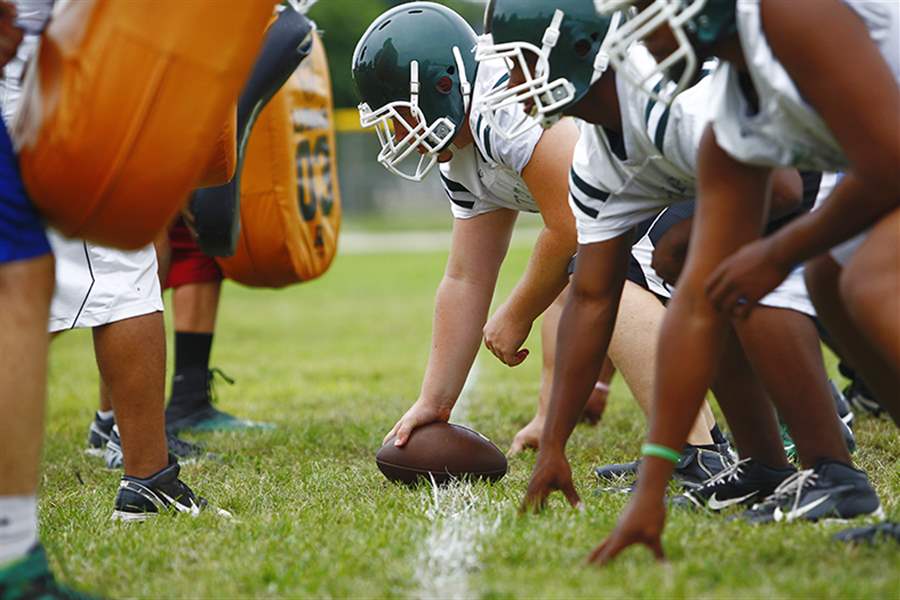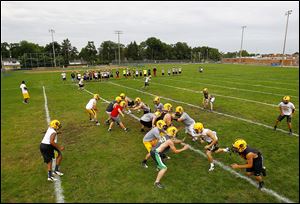
Think spring? The dilemma of high school spring football
4/27/2014
Players at Start High line up on the first day of practices last August. Ohio doesn’t allow spring practices while other football-rich states like Florida (20 practices) and Texas (15) have spring drills.
THE BLADE
Buy This Image

Northview’s football team hits the field during the first practice day in August, when Ohio teams begin preparing for the season. Ohio ranked fifth last year in putting players on major college rosters.
Like in Ohio, high schools down south are smack in the middle of their spring sports calendar.
There’s just one small twist. It is football season.
Friday night lights are back in Texas, same as in Alabama, Georgia, and Florida — among at least 15 states where baseball, track, and tennis give way to full-pads spring football practices.
At St. Thomas Aquinas, a football powerhouse in Fort Lauderdale, Fla., coach Rocco Casullo can’t imagine life without spring workouts. In 20 practices over a span of 23 days, he will break in last year’s junior varsity players, install an offense, and showcase his stars. College coaches attend every practice while nearly 100 of them are expected at the team’s annual Blue and Gold game next month.
"It’s a huge asset for us," Casullo said.
Ohio, meanwhile, endures as a spring frontier — even as the state’s most powerful football voice hopes to change that.
While Ohio State coach Urban Meyer has pushed for a scaled-down version of spring football in Ohio, the state’s high school athletic association is not budging. A sampling of several area high schools also revealed hesitation, with football and baseball coaches citing the potential damage to traditional spring sports and concerns of overspecialization.
"I’m having a hard time wrapping my mind around it," said Mike Vicars one of northwest Ohio’s most successful high school football coaches, now at Swanton. "When is enough enough? We already have 10 coaching days in the summer. I believe there is a value to having kids that are hungry when they come out rather than football, football, football. If you overdo it, there's just as much danger of burning the kids out as there is improving their skills."
Push for more instruction
As it stands, high school coaches in Ohio are allowed to instruct up to four players at a time during the spring. They then have a 10-day period over June and July in which they can hold camps, practices, and seven-on-seven scrimmages.
Meyer has sought more player access for the coaches since the day he was hired at OSU. At the state coaches clinic in 2012, Meyer told the crowd, "If there's any way to get 10 days of spring football in the state of Ohio, then I'm here to help you."
Meyer told The Blade he is unsure where the ideal middle ground lies. He explained he is advocating for coaches to have more instruction time with their players, not a bruising spring practice season. He said he is sensitive to safety concerns and other spring sports — especially as the debate becomes personal. Meyer’s son, Nate, is set to enter high school, where he will play football and baseball next season.
"This is a whole different animal now because it's my son," said Meyer, a former minor league player in the Atlanta Braves organization. "I would never want to see a spring sport, whether it is track or baseball, be affected by football because I don't think that's right, either. But there's enough time in the year where you can certainly work on football.
"Ohio has the best coaches, in my opinion, in the country. It's old-fashioned coaching, and they still have control of their players and the program. You're not dealing with third parties. High school players should be coached by their high school coaches and I want my son to be coached by his high school coach and not have to send him other places."
More football could also help college coaches better size up Ohio’s top prospects. The spring recruiting evaluation period runs from April 15 to May 31, or the same time as schools in warm-weather hotbeds like Texas (18 spring practices) and California (10 practices) are cracking helmets.
"It's much easier to evaluate down in the south because you get to physically watch them practice [in the spring]," Meyer said. "Here you go sit in the weight room and maybe watch them or maybe they do some skill work. That's another year of football, the way you look at it. Four years of spring football, that's basically five years of high school football getting you ready to go."
Still, even a downsized spring football season may be unlikely. While the Ohio High School Athletic Association acknowledged some coaches are in favor of the move, commissioner Dan Ross is not ready to open that door.
"However, there are many coaches in Ohio who do not want spring football practice for various reasons, such as they also coach a spring sport, they need a break from practice in the spring, or they won’t receive any additional compensation to conduct spring practice," OHSAA spokesman Tim Stried said in a statement to The Blade. "First and foremost, though, the OHSAA has not supported spring football practice to protect participation in the sanctioned spring sports.
Many of our member schools have told us that they would struggle to field baseball, track, or boys tennis teams in the spring if they lost student-athletes who were preparing for spring football practice."
Stried also cited a recent NCAA study that found six percent of high school football players play the sport in college — only a percentage of which do so at the major-conference level.
"So adopting spring football practice to help with the college recruiting process goes against the OHSAA’s philosophy of high school sports participation," he said.
Conflict with other sports
Area coaches mostly agree: There is no easy way to implement spring practice.
What may work at the state’s biggest Division I schools may not work at smaller schools, and what works in Florida does not work in Ohio, where stubborn winters yield a brief and already crammed window for spring sports. For instance, while Florida’s track and field season begins in late January and ends with the state finals May 3, the state meet in Ohio begins June 6. Neighboring states facing the same issue — Michigan, Indiana, and Pennsylvania — also do not sanction spring football.
"The only way I could see it would work is make baseball a summer sport and start baseball in May," said longtime Perrysburg baseball coach Dave Hall, who also coached football for 25 years. "But then football coaches would want their kids in July, and you can't have it both ways."
A survival-of-the-fittest landscape with football and other spring sports overlapping may be just as unlikely. Take Central Catholic, where 10 of 18 varsity baseball players also play football. Or Perrysburg, where 26 of the 40 players in the baseball program double up.
"At a school like ours, the football coach is going to step on some toes if he requires guys to do spring football," Perrysburg football coach Matt Kregel said.
Central baseball coach Jeff Mielcarek called spring football a "horrible idea," saying it could force athletes to choose one sport over another and only accelerate the trend toward specialization.
"Boy, I'd really like to play baseball in the fall," he said with a laugh. "But do you think that will happen?"
Football coaches say they are sensitive to the concerns — and the political tension a spring-tug-of war would invite.
"How do you tell a coach, ‘Hey, I know you’re in the middle of your season, but I'm going to take your star pitcher and let them whack him around,’" Central football coach Greg Dempsey said. "Then that ruins a season for a sport. That would just be so tough to deal with.
"Would I love to be out in the spring coaching football? Yeah, because I love doing that. But then what if a kid gives up a sport. Then you end up hurting your school, and what's the gain for the high school kid at the end of the day?"
Probably not much. There is little evidence the lack of spring football holds back Ohio players.
The state continues to lap the rest of the Midwest in producing elite football players. Last year, Ohio ranked fifth behind behind California, Texas, Florida, and Georgia in both its number of natives on NFL rosters (74) and high school prospects who signed with Football Bowl Subdivision schools (145). For perspective, Alabama had the sixth-most FBS prospects last year with 83.
More telling, it is not just that Ohio is the nation’s seventh-most populous state. Ohio players filled FBS rosters in 2012 at a per-capita rate of 1.61 times the national average — higher than California (0.97) and about even with Texas (1.63) — according to a study by Theodore Goudge, a sport geographer at Northwest Missouri State. No other state north of Arkansas and east of Nebraska meets the national average.
Dempsey, Vicars, and Kregel appreciate both sides of the spring football arguments, and Meyer said it is coaches like them who will decide what is right for Ohio. Maybe there is a way to loosen the four-players-at-a-time restriction. Maybe the OHSAA will stand firm. Meyer said he only wants what is best for his home state, saying at a recent luncheon, "When I start talking about tradition, football is here."
"Football is Ohio," he said. "Ohio is football."
For now, this football state remains silent in the spring, even as the debate rings louder than ever.
Contact David Briggs at: dbriggs@theblade.com, 419-724-6084 or on Twitter @DBriggsBlade.